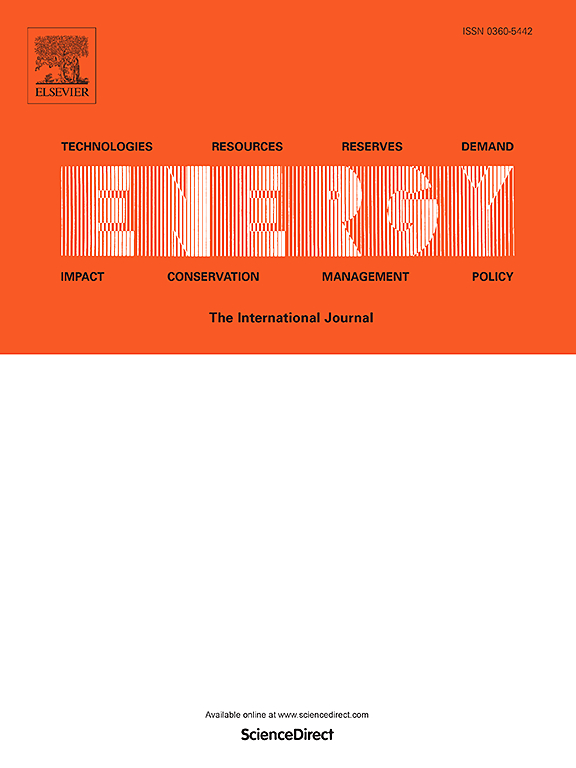水泵模式下水泵水轮机旋转失速演化规律及能量损失特性研究
IF 9
1区 工程技术
Q1 ENERGY & FUELS
引用次数: 0
摘要
在全球能源转型和环境保护的双重背景下,抽水蓄能是维持电力系统可靠运行的关键储能技术。水泵水轮机作为抽水蓄能电站的核心部件,其运行稳定性至关重要。然而,频繁的工况转换会导致水泵水轮机在非设计工况下发生旋转失速,严重影响机组的能量转换效率和稳定运行。本研究以某电厂水泵水轮机模型为研究对象。采用实验与非定常模拟相结合的方法,对水泵水轮机在泵工况下的旋转失速机理进行了深入研究。详细分析了旋转失速的周向演化规律及失速消失的原因。同时还阐明了相关的能量转换特性,包括压力波动、湍流动能和熵产率。结果表明,旋转失速主要发生在导叶。随着流量的减小,旋转失速位置向导叶入口移动,失速单元数量总体呈减少趋势。旋转失速的周向演变主要是由于失速通道的堵塞,引起流动偏转并改变通道内的逆压梯度。这就驱动失速涡的前端沿流道旋转方向进入下一个非失速通道,而失速涡的后端则退出失速通道,形成旋转失速。另外,从能量损失的角度来看,转轮出口流态分布不均匀是驼峰区谷态Op3下旋转失速消失的重要原因。该研究进一步拓展了对水轮机旋转失速机理的认识,为水轮机的优化设计和运行控制提供了重要依据。本文章由计算机程序翻译,如有差异,请以英文原文为准。
Research on the evolution law and energy loss characteristics of rotating stall in a pump-turbine under pump mode
Under the dual background of global energy transformation and environmental protection, pumped storage is a key energy storage technology to maintain the reliable operation of power systems. As the core component of pumped storage power plants, the operation stability of pump-turbine is of great importance. However, frequent operating condition transitions can trigger rotating stall in pump-turbine under off-design conditions, which seriously affects the energy conversion efficiency and stable operation of the unit. In this study, the pump-turbine model of a certain power plant is taken as research object. A combination of experiment and unsteady simulation is used to thoroughly investigate the mechanism of rotating stall in pump-turbine under pump mode. The circumferential evolution law of rotating stall and the reasons for its disappearance are analyzed in detail. The associated energy conversion characteristics are also elucidated, including pressure fluctuations, turbulent kinetic energy, and entropy production rate. The results show that rotating stall mainly occurs in the guide vane. As the flow rate decreases, the location of rotating stall shifts towards the guide vane inlet and the number of stall cells generally shows a decreasing trend. The circumferential evolution of rotating stall is primarily due to the blockage of stalled channels, which induces flow deflection and alters the adverse pressure gradient within the channels. This drives the front end of stall vortices to move along the runner rotation direction into the next non-stalled channel, while the rear end of the stall vortices exits the stalled channel, resulting in the formation of rotating stall. Additionally, from the perspective of energy loss, the uneven flow state distribution at the runner outlet is an important reason for the disappearance of rotating stall under the valley condition Op3 in hump region. This study further expands the understanding of the mechanism of rotating stall in pump-turbines, and provides important bases for optimization design and operation control of pump-turbines.
求助全文
通过发布文献求助,成功后即可免费获取论文全文。
去求助
来源期刊

Energy
工程技术-能源与燃料
CiteScore
15.30
自引率
14.40%
发文量
0
审稿时长
14.2 weeks
期刊介绍:
Energy is a multidisciplinary, international journal that publishes research and analysis in the field of energy engineering. Our aim is to become a leading peer-reviewed platform and a trusted source of information for energy-related topics.
The journal covers a range of areas including mechanical engineering, thermal sciences, and energy analysis. We are particularly interested in research on energy modelling, prediction, integrated energy systems, planning, and management.
Additionally, we welcome papers on energy conservation, efficiency, biomass and bioenergy, renewable energy, electricity supply and demand, energy storage, buildings, and economic and policy issues. These topics should align with our broader multidisciplinary focus.
 求助内容:
求助内容: 应助结果提醒方式:
应助结果提醒方式:


